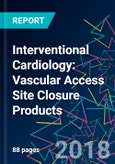Overview
Markets covered by this analysis include the US, Japan, the five major EU markets (France, Germany, Italy, Spain, and the UK), and the Rest of World (RoW) markets, which includes all other countries. This analysis includes a discussion of products, current/forecast markets, competitors, and opportunities in the markets for vascular access site closure products, which include active and passive vascular closure devices, as well as other hemostatic products (eg dressings, manual compression assist devices, radial compression bands).
The global market for vascular access site closure products is anticipated to see moderate, single-digit growth throughout the forecast period covered by this analysis (2017-22). Growth in unit sales is being driven by the increasing prevalence of cardiovascular disease, which is the leading cause of death globally, responsible for over 17 million deaths annually. Primary research querying interventional cardiolog.regarding device preferences and utilization was leveraged in the formulation of this report's forecasts and analyses. Global product sales are projected to expand at a compound annual growth rate (CAGR) of 6.5% during the 2017-22 forecast, increasing from approximately $748.8m in 2017 to an estimated $1,023.8m in 2022.
Markets covered by this analysis include the US, Japan, the five major EU markets (France, Germany, Italy, Spain, and the UK), and the Rest of World (RoW) markets, which includes all other countries. This analysis includes a discussion of products, current/forecast markets, competitors, and opportunities in the markets for vascular access site closure products, which include active and passive vascular closure devices, as well as other hemostatic products (eg dressings, manual compression assist devices, radial compression bands).
The global market for vascular access site closure products is anticipated to see moderate, single-digit growth throughout the forecast period covered by this analysis (2017-22). Growth in unit sales is being driven by the increasing prevalence of cardiovascular disease, which is the leading cause of death globally, responsible for over 17 million deaths annually. Primary research querying interventional cardiolog.regarding device preferences and utilization was leveraged in the formulation of this report's forecasts and analyses. Global product sales are projected to expand at a compound annual growth rate (CAGR) of 6.5% during the 2017-22 forecast, increasing from approximately $748.8m in 2017 to an estimated $1,023.8m in 2022.
Table of Contents
Executive Summary
Cardiovascular Diseases Overview
Vascular Access Site Closure Products
Vascular Access Site Closure Products Market
Exhibit 3-1: Vascular access site closure products, global market forecast, 2017-22








